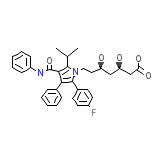Cardyl




Categoria
Cardyl Nombres de marca, Cardyl Analogos
Cardyl Marca los nombres de mezcla
Cardyl Formula quimica
C33H35FN2O5
Cardyl RX enlace
http://www.rxlist.com/cgi/generic/atorvastatin.htm
Cardyl FDA hoja
Cardyl MSDS (hoja de seguridad de materiales)
Cardyl Sintesis de referencia
BD Roth, EE.UU. Pat. 5273, 995 (1991, 1993)
Cardyl Peso molecular
558.64 g/mol
Cardyl Punto de fusion
159.2-160.7oC
Cardyl H2O Solubilidad
Sodio soluble en agua salada, el 20,4 ug / ml (pH 2,1), 1,23 mg / ml (pH 6,0)
Cardyl Estado
Solid
Cardyl LogP
6.259
Cardyl Formas de dosificacion
Comprimido (10 mg, 20 mg o 40 mg)
Cardyl Indicacion
Para la gestión como un complemento a la dieta para reducir los niveles de C-total, LDL-C, apo B, y los niveles de TG en pacientes con hipercolesterolemia primaria y dislipidemia mixta.
Cardyl Farmacologia
Atorvastatina, un selectivo y competitivo de la HMG-CoA reductasa, se utiliza para reducir el colesterol y los triglicéridos en pacientes con hipercolesterolemia y dislipidemia mixta y en el tratamiento de homocigotos hipercolesterolemia familiar. Atorvastatina tiene una estructura única, larga vida media, y la selectividad hepática, que explica su mayor potencia de disminución de LDL en comparación con otros inhibidores de la HMG-CoA reductasa.
Cardyl Absorcion
La atorvastatina se absorbe rápidamente tras la administración oral. La biodisponibilidad absoluta de atorvastatina (droga madre) es de aproximadamente 14% y la disponibilidad sistémica de inhibidores de la HMG-CoA reductasa actividad inhibitoria es de aproximadamente 30%.
Cardyl Toxicidad
Rabdomiolisis, hemorragias oculares, y problemas hepáticos.
Cardyl Informacion de Pacientes
Lipitor is a HMG-CoA Reductase Inhibitor, also known as a statin. This class
of treatments for high cholesterol is fairly new, and appears to work by
blocking a liver enzyme which generates cholesterol. This medication appears
to be the most effective in this class of drugs at lowering unhealthy LDL
(low-density lipoprotein) cholesterol levels, in some cases up to 51%. It
can be virtually as effective as an angioplasty in treating stable coronary
artery disease. Currently, this drug is approved for use in patients with
high cholesterol (hypercholesterolemia) due to high LDL levels, hereditary
elevated fat levels (dysbetalipoproteinemia), familial high cholesterol,
and to increase HDL (high-density lipoprotein) levels in patients with high
cholesterol and those with both high cholesterol and high triglycerides (mixed
dyslipidemia). Other accepted uses include the treatment of stable coronary
artery diseas, preventing coronary heart disease, preventing clogged stents
(tubes) placed in coronary arteries after surgery, preventing bone loss in
type two diabetics, stabilizing lipid levels that have been altered by treatment
with protease inhibitors. This treatment should be considered a last resort.
The best way to lower cholesterol is through a program of healthy diet and
exercise, and these should be maintained during treatment with Lipitor.
of treatments for high cholesterol is fairly new, and appears to work by
blocking a liver enzyme which generates cholesterol. This medication appears
to be the most effective in this class of drugs at lowering unhealthy LDL
(low-density lipoprotein) cholesterol levels, in some cases up to 51%. It
can be virtually as effective as an angioplasty in treating stable coronary
artery disease. Currently, this drug is approved for use in patients with
high cholesterol (hypercholesterolemia) due to high LDL levels, hereditary
elevated fat levels (dysbetalipoproteinemia), familial high cholesterol,
and to increase HDL (high-density lipoprotein) levels in patients with high
cholesterol and those with both high cholesterol and high triglycerides (mixed
dyslipidemia). Other accepted uses include the treatment of stable coronary
artery diseas, preventing coronary heart disease, preventing clogged stents
(tubes) placed in coronary arteries after surgery, preventing bone loss in
type two diabetics, stabilizing lipid levels that have been altered by treatment
with protease inhibitors. This treatment should be considered a last resort.
The best way to lower cholesterol is through a program of healthy diet and
exercise, and these should be maintained during treatment with Lipitor.
Cardyl Organismos afectados
Humanos y otros mamíferos














